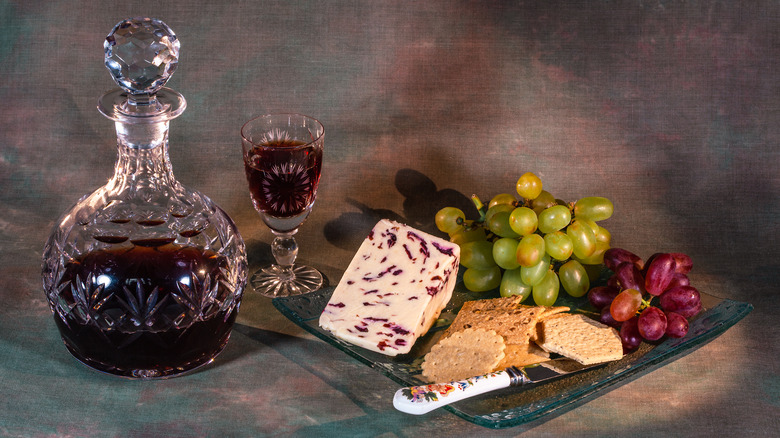New To Port? Start With This Surprisingly Affordable Option
Port is a timeless classic that dates back to the 17th century, exclusively cultivated in sun-drenched, terraced vineyards nestled among the fertile hills of the Douro Valley. What makes port unique among other wine variations is that it's fortified. This means that during the fermentation process, a spirit is added — usually aguardente — which halts fermentation. The result is a high alcohol content (19% to 22%) and leftover residual sugars, endowing port with its signature sweet flavor (which is why it's typically served with dessert rather than the main course). If you're looking to explore the world of port but don't know where to begin, we've got you covered. Food Republic consulted Rocco Carulli, owner and executive chef of R HOUSE, who revealed ruby port is his go-to recommendation for beginners.
The four large families of port wine are ruby, tawny, white, and rosé — all of which vary in taste, aging method, intended drinking style, and of course, price. According to Carulli: "[Ruby port is] the most approachable, fruit-forward style that gives you a solid idea of what port can offer without overwhelming the palate or your wallet." It effectively highlights the sweet, fruit-forward characteristics of port, offering a beginner-friendly taste profile compared to the nutty, oxidative flavors of tawny port or the concentrated, tannic, full-bodied, and often expensive, high-quality vintage port.
As for specific beginner-friendly brands, Carulli recommends: "Brands like Fonseca Bin 27 or Graham's Six Grapes are excellent starting points." You can typically expect to find a standard bottle of either option in the range of $14 to $30, depending on the retailer, promotions, and your location.
Unlock ruby port's flavors and ideal food partners
Wondering how to approach a wine tasting, especially when faced with complex tasting notes? Don't let that discourage you. With even a little understanding, tasting notes can become valuable tools to help you identify specific characteristics you enjoy in a wine. For example, when buying your first bottle of ruby port, Rocco Carulli recommends: "Look for notes of dark cherry, plum, raisin, and a hint of chocolate — that's the ruby port comfort zone. It should feel rich but not heavy." These dark fruit notes suggest a rich, approachable profile that balances sweetness and depth. Usually served slightly chilled, it offers a smooth and velvety texture — and for the best port sipping experience, opt for a chimney-shaped wine glass.
When it comes to food pairings, ruby port is actually extremely versatile. The rich, fruity flavors strike an excellent balance with all kinds of sweets — though Carulli told us it pairs especially well with "dark chocolate dessert[s]," where the bitter chocolate and the dark-fruit notes bounce off each other to create a unique and layered flavor experience.
If you're interested in broadening your port experience even further, you could also serve it alongside savory dishes. Ruby port harmonizes wonderfully with "blue cheese, or even a charcuterie board with aged cheddar or figs," Carulli added.The contrast in flavors will highlight port's natural sweetness and enhance its complexity, allowing you to fully appreciate its delicious aromas.


